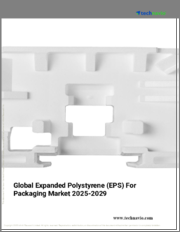
|
시장보고서
상품코드
1752331
세계의 재생 EPS 산업 전망(-2034년)Global Recycled EPS Industry Outlook Report Till 2034 |
||||||
스티로폼(Styrofoam)으로 널리 알려진 스티로폼(EPS)은 환경에 미치는 영향 때문에 오랫동안 비판을 받아왔습니다. 그러나 최근 몇 년간의 재활용 기술 발전과 혁신적인 접근 방식으로 인해 이 소재가 보다 지속 가능하고 순환 가능한 미래를 실현할 수 있는 기회가 생겨나고 있습니다.
최근 몇 년 동안 스티로폼의 효율적이고 효과적인 재활용 방법의 개발이 크게 진전되었습니다. 중요한 기술 혁신 중 하나는 EPS 폐기물을 분쇄, 용융, 개질하여 재사용 가능한 펠릿으로 만들어 새로운 제품 생산에 활용하는 기계적 재활용입니다. 기계적 재활용은 비용 효율적이고 재료의 원래 특성을 유지할 수 있기 때문에 인기를 얻고 있습니다.
스티로폼 재활용에 대한 수요 증가에 대응하기 위해 전 세계적으로 새로운 재활용 시설이 설립되고 있습니다. 이 공장들은 EPS 폐기물을 효율적으로 처리할 수 있는 첨단 선별 및 처리 장비를 갖추고 있습니다. 예를 들어, 미국에서는 Foam Recycling Coalition이 여러 EPS 재활용 센터의 설립을 지원했습니다. 이러한 시설들은 EPS 폐기물을 매립하는 대신 귀중한 자원으로 전환하는 데 필수적인 역할을 하고 있습니다.
재생 스티로폼은 다양한 용도의 원료로 점점 더 많이 사용되고 있습니다. 재생 EPS는 단열성이 우수하여 단열재로도 사용되고 있습니다. 따라서 에너지 소비를 줄이고 온실가스 배출을 줄이는 건축 용도에 적합합니다.
자동차 산업도 재생 EPS를 사용하여 인테리어 패널, 보호 포장 등 경량화 부품을 생산하고 있습니다. 기존 소재를 재생 EPS로 대체함으로써 자동차 제조업체는 차량 무게를 줄여 연비를 개선하고 이산화탄소 배출량을 줄일 수 있습니다. 또 다른 중요한 용도는 건설 부문으로, 재생 EPS는 벽체 단열재, 방음재, 구조용 블록 및 패널 제작에 사용되고 있습니다. 이러한 기술 혁신은 폐기물을 줄이고 자원을 보호하면서 버진 소재에 대한 의존도를 낮추는 데 기여하고 있습니다.
세계 각국 정부는 스티로폼과 관련된 환경 문제를 인식하고, 그 악영향을 최소화하기 위한 재활용 활동과 규제를 추진하고 있습니다. 캐나다, 독일, 한국 등의 국가들은 확대 생산자 책임 프로그램을 도입하여 회수 및 재활용을 포함한 제품의 전체 라이프사이클에 대해 제조업체에 책임을 부여하고 있습니다.
또한, 여러 지역 및 지방 자치 단체에서 일회용 스티로폼 제품의 사용을 금지하거나 제한하고 있습니다. 이러한 조치로 인해 기업들은 대체품을 찾거나 재활용 가능한 EPS 소재를 사용하도록 장려하고 있습니다. 예를 들어, 퀘벡에 본사를 둔 Nexkemia Petrochemicals는 2023년 퀘벡 주에서 가장 큰 EPS 재활용 업체인 Eco-Captation을 인수했습니다. 이번 인수는 EPS 재활용과 지속 가능한 원료에 대한 투자를 통해 순환 경제를 촉진하기 위한 Nexkemia의 노력을 반영합니다. 또한, 호주 빅토리아 주 정부는 2023년 2월 식음료 용기, 빨대, 접시, 수저 등 일회용 플라스틱 및 폴리스티렌 제품의 사용을 금지하는 획기적인 조치를 시행하여 지속 가능한 대체품으로의 전환을 더욱 촉진하고 있습니다.
재생 스티로폼 시장은 최근 몇 년 동안 크게 성장하고 있습니다. 지속 가능하고 친환경적인 소재에 대한 수요가 증가함에 따라 재생 EPS는 버진 폴리스티렌을 대체할 수 있는 유력한 대안으로 각광받고 있습니다.
건설 산업은 이러한 성장의 주요 촉진요인이며, 재생 EPS를 기반으로 한 단열 블록과 단열 패널은 우수한 단열 특성으로 인해 인기가 높아지고 있습니다. 건축업자들은 벽과 지붕에 재생 EPS를 사용함으로써 에너지 절약 효과를 높이 평가하고 있으며, 냉난방 비용 절감에 도움이 되고 있습니다. 또한, 재생 EPS를 사용한 건축자재는 방음성도 향상시켜 주거공간과 작업공간의 쾌적성을 높여줍니다.
세계의 재생 EPS 산업에 대해 조사 분석했으며, 시장 역학 및 산업 동향, 각 부문별 수요, 제조업체 프로파일 등의 정보를 전해드립니다.
목차
제1장 서론
제2장 이용 규약
제3장 주석
제4장 시장 요약
- 시장 발전
- 수요 개요
- 산업 구조
- 전략상 문제
- 최종 용도 동향
- 성장 예측
제5장 세계 경제 전망
- GDP와 인구통계
- 금융 정책과 재정 정책
제6장 에너지 전망
- 원유
- 천연가스
- 전기요금
제7장 최종 용도 부문 실적
- 소비재
- 포장
- 건축 및 건설
- 기타
제8장 재생 EPS 서론과 시장 개요
- 제품 설명
- 등급과 특성
- 원재료
- 제조 공정
- 환경 문제
- 밸류체인
- 용도
제9장 시장 역학과 산업 동향
- 시장 역학
- 성장 촉진요인
- 성장 억제요인
- 기회
- 과제
- 산업 구조
제10장 세계의 재생 EPS 수요 분석 : 재활용 기술별, 용도별(수량과 금액)(2018년-2034년)
- 전략상 문제
- 수요 분석과 예측(2018년-2034년)
- 수요
- 수요 성장률
- 성장 촉진요인 분석
- 세계의 재생 EPS 시장 : 재활용 기술별
- 매트리얼 재활용
- 케미컬 재활용
- 세계의 재생 EPS 시장 : 용도별
- 용기
- 포장
- 건설
- 기타
제11장 수요 분석과 시장 리뷰 : 지역/국가별(수량과 금액)(2018년-2034년)
- 전략상 문제
- 수요 분석과 예측(2018년-2034년)
- 수요
- 수요 성장률
- 재생 EPS 시장 : 재활용 기술별
- 재생 EPS 시장 : 용도별
- 북미
- 미국
- 캐나다
- 멕시코
- 서유럽
- 독일
- 프랑스
- 이탈리아
- 영국
- 스페인
- 기타 서유럽
- 중유럽 및 동유럽
- 러시아
- 폴란드
- 기타 중유럽 및 동유럽
- 아시아태평양
- 중국
- 일본
- 인도
- 한국
- 기타 아시아태평양
- 중남미
- 중동 및 아프리카
제12장 기회 평가
- 시장의 매력 평가
- 전망과 타겟 시장 조사
제13장 전략적 추천과 제안
제14장 가격 분석
- 평균 가격
- 가격 예측
제15장 기업 분석
- 재생 EPS 제조업체 개요/기업 분석
- 기본 상세
- 본사 및 주요 시장
- 소유
- 기업 재무
- 제조거점
- 세계의 판매
- 총 직원수
- 제품 포트폴리오/서비스/솔루션
- 최근 발전
대상 기업
- J-EPS recycling
- INTCO
- Let's Recycle It Limited
- 기타 제조업체
제16장 부록
LSHExpanded polystyrene (EPS), widely known as Styrofoam, has long been criticized for its environmental impact. However, recent advancements in recycling technologies and innovative approaches are now creating opportunities for a more sustainable and circular future for this material.
In recent years, there has been notable progress in developing efficient and effective recycling methods for expanded polystyrene. One important innovation is mechanical recycling, which involves grinding, melting, and reforming EPS waste into reusable pellets that can be used to make new products. Mechanical recycling has gained popularity because it is cost-effective and helps preserve the material's original properties.
To support the growing demand for expanded polystyrene recycling, new recycling facilities have been established globally. These plants are equipped with advanced sorting and processing equipment to handle EPS waste efficiently. For example, in the United States, the Foam Recycling Coalition has helped set up multiple EPS recycling centers. These facilities have been essential in diverting EPS waste from landfills and transforming it into valuable resources.
Recycled expanded polystyrene is increasingly being used as a raw material in a variety of applications. It is also used as insulation materials, as recycled EPS offers excellent thermal insulation. This makes it ideal for building applications where it helps reduce energy consumption and lower greenhouse gas emissions.
The automotive industry has also embraced recycled EPS by using it to produce lightweight components such as interior panels and protective packaging. By replacing traditional materials with recycled EPS, car manufacturers can reduce vehicle weight, leading to better fuel efficiency and lower carbon emissions. Another important application is in the construction sector, where recycled EPS is used to make blocks and panels for wall insulation, soundproofing, and even structural purposes. These innovations help reduce reliance on virgin materials while contributing to waste reduction and resource conservation.
Governments around the world have recognized the environmental challenges associated with expanded polystyrene and are promoting recycling initiatives and regulations to minimize its negative impact. Countries such as Canada, Germany, and South Korea have introduced extended producer responsibility programs, which make manufacturers responsible for the entire lifecycle of their products, including collection and recycling.
Additionally, various regions and municipalities have implemented bans or restrictions on single-use expanded polystyrene products. These measures encourage businesses to find alternatives or use recyclable EPS materials. For example, Quebec-based Nexkemia Petrochemicals acquired Eco-Captation, Quebec's leading post-consumer EPS recycler, in 2023. This acquisition reflects Nexkemia's commitment to advancing a circular economy by investing in EPS recycling and sustainable raw materials. Furthermore, the Victorian state government in Australia implemented a groundbreaking ban in February 2023 on single-use plastics and polystyrene products, including food and drink containers, straws, plates, and cutlery, further pushing the shift toward sustainable alternatives.
The market for recycled expanded polystyrene has grown substantially in recent years. With increasing demand for sustainable, eco-friendly materials, recycled EPS is gaining traction as a viable substitute for virgin polystyrene.
The construction industry has been a key driver of this growth, with recycled EPS-based insulation blocks and panels becoming more popular due to their outstanding thermal insulation properties. Builders and architects appreciate the energy-saving benefits of using recycled EPS in walls and roofs, which helps reduce heating and cooling costs. Additionally, construction materials made from recycled EPS also improve soundproofing, enhancing comfort in living and working spaces.
Table of Contents
1. Introduction
2. Terms & Conditions of Use
3. Explanatory Notes
- Market Coverage
- Recycling Technology
- Application
- Regions
- Countries
- Years Considered
- Historical - 2018 - 2023
- Base - 2024
- Forecast Period - 2025 - 2034
- Research Methodology
- Approach
- Research Methodology
- Prismane Consulting Market Models
- Assumptions & Limitations
- Abbreviations & Definitions
- Conversion Factors
- Data Sources
4. Market Synopsis
- Market Evolution
- Demand Overview
- Industry Structure
- Strategic Issues
- End-use Trends
- Growth Forecast
5. Global Economic Outlook
- GDP and Demographics
- Monetary & Fiscal Policies
6. Energy Outlook
- Crude Oil
- Natural Gas
- Electricity Prices
7. End-use Sector Performance
- Consumer Goods
- Packaging
- Building & Construction
- Others
8. Introduction to Recycled EPS and Market Overview
- Product Description
- Grades & Properties
- Raw Material
- Manufacturing Process
- Environmental Issues
- Value Chain
- Applications
9. Market Dynamics and Industry Trends
- Market Dynamics
- Drivers
- Restraints
- Opportunities
- Challenges
- Industry Structure
10. Global Recycled EPS Demand Analysis, By Recycling Technology, By Application (Volume, Value) (2018 - 2034)
- Strategic Issues
- Demand Analysis and Forecast (2018 - 2034)
- Demand
- Demand Growth Rate (%)
- Driving Force Analysis
- Global Recycled EPS Market, By Recycling Technology
- Material recycling
- Chemical recycling
- Global Recycled EPS Market, By Application
- Containers
- Packaging
- Construction
- Others
11. Demand Analysis and Market Review, By Region, By Country (Volume, Value), (2018 - 2034)
- Strategic Issues
- Demand Analysis and Forecast (2018 - 2034)
- Demand
- Demand Growth Rate (%)
- Recycled EPS Market, By Recycling Technology
- Recycled EPS Market, By Application
Note: Demand Analysis has been provided for all major Regions / Countries as mentioned below. The demand (consumption) split by Recycling Technology, and by Application has been provided for each of the countries / regions in Volume (Kilo tons) and Value (USD Million).
- North America
- USA
- Canada
- Mexico
- Western Europe
- Germany
- France
- Italy
- United Kingdom
- Spain
- Rest of Western Europe
- Central & Eastern Europe
- Russia
- Poland
- Rest of Central & Eastern Europe
- Asia-Pacific
- China
- Japan
- India
- South Korea
- Rest of Asia-Pacific
- Central & South America
- Middle East & Africa
Note: CAGR will be calculated for all the applications to arrive at the regional / global demand growth for the forecast period (2025 - 2034)
12. Business Opportunity Assessment
- Market Attractiveness Assessment
- Prospective & Target Market Study
13. Strategic Recommendation & Suggestions
14. Pricing Analysis
- Average Prices
- Price Forecast
15. Company Analysis
- Recycled EPS Manufacturers Profiles/ Company Analysis
- Basic Details
- Headquarter, Key Markets
- Ownership
- Company Financial
- Manufacturing Bases
- Global Turnover
- Total Employee
- Product Portfolio / Services / Solutions
- Recent Developments
Companies Covered -
- J-EPS recycling
- INTCO
- Let's Recycle It Limited
- Other Manufacturers
Note: This section includes company information, company financials, manufacturing bases and operating regions. Company financials have been mentioned only for those companies where financials were available in SEC Filings, annual reports, or company websites. All the reported financials in this report are in U.S. Dollars. Financials reported in other currencies have been converted using average currency conversion rates. Company profiles may include manufacturers, suppliers, and distributors.
16. Appendices
- Target Markets
- Demand - Regions
- Demand - Countries

















